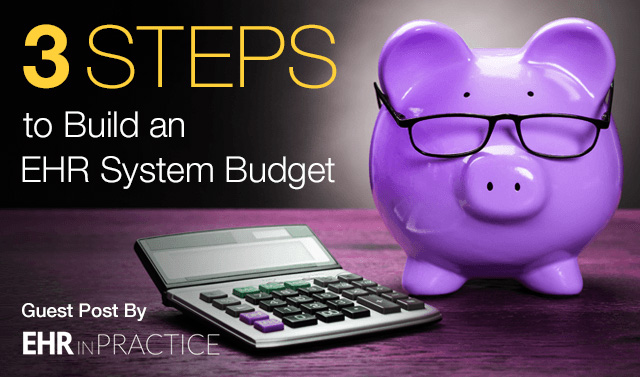Steps to Help Build an Accurate EHR System Budget

It’s inevitable that implementing an electronic health record (EHR) system will cost money. Building an accurate budget from the outset is imperative as it will help dictate the success of your EHR vendor selection project. A clear financial plan at this stage will also help your practice avoid any unwelcome surprises that may arise later down the line. Here are three useful steps designed to assist you when compiling your EHR budget.
1. Plan for the cost ongoing staff training
First and foremost, staff training should be a major cost consideration – as a practice, you shouldn’t underestimate the level of resources required for a successful implementation. We know that 84% of employees in the best performing organizations are receiving the training they need, compared with only 16% in the worst performing companies.
When comparing EHR costs, you will need to factor in supplementary educational resources if they aren’t already included in the price. Some EHR vendors will provide online training and video tutorials, for example.
Equally, you should plan to accommodate a range of users with varying levels of skill. Depending on the size of the practice, it might be a good idea to nominate one person per department to act as technical support or a super user.
Before you go live having training options that are flexible and won’t impact your patient flow are key. Training should not take the staff or providers away from treating patients. Having flexible options such as:
- Weekend training clinics
- Web trainings during lunch or after clinic
- Regularly scheduled phone/web calls
- Access to an online knowledge base
The only time that trainings should impact and reduce patient volume by 15-20% is when training staff is shadowing the physician for onsite support. Pre-go-live training should never hinder your practice’s productivity or impact revenue.
After go-live, collect feedback from staff to address any issues that might occur through practical day-to-day use. Training shouldn’t end here; it should be ongoing. Increasing your budget for refresher training to ensure physicians and end-users have the tools to utilize the system to the best of their abilities should help in overcoming any initial challenges to workflow. EHR companies will often host annual conferences for clients, which are often valuable learning opportunities for staff as well.
2. Work out your potential ROI as a practice
Although it varies depending on your EHR vendor, there will be some ongoing costs to using your EHR system. Factors such as number of users, number of devices, days per week you see patients or volume of patients can significantly affect how much you pay.
Pay attention to those benefits which can be quantified such as improved operational efficiency and increased revenue. Don’t forget to include non-quantifiable benefits such as better job satisfaction amongst staff and improved patient outcomes.
For example, participants in a recent study reported improvements in their ability to manage patient information after the implementation of EHR systems, citing improved ability to manage results such as obtaining test results from laboratories and following the results of an investigation over time (64%, 11/17 clinics).
Although non-quantifiable benefits are, by definition, difficult to assess financially there are alternative ways of measuring the impact of streamlined workflow in practices. You can, for example, analyze the reduction in personnel and payroll.
Remember that any initial losses in productivity are a small price to pay if it means productivity improves in the long-term. You need to establish whether the initial investment will be balanced by the ability to see more patients, speed-up reimbursements and help your providers stay compliant with federal law.
3. Factor in contingency for software updates
Try, where possible, to anticipate the needs of the practice so you can eliminate the risk of creating challenges down the line. If you choose an EHR system that is suitable for the moment, but does not have functionality required for future growth then you could be making a very costly decision.
In addition to the recurring costs of maintenance, there’s a possibility of hidden costs. For example, any customizations that need to be made or interfaces with other management applications.
The final, but perhaps most important, question you must ask yourself is will this new EHR enable your practice to adhere to the regulations for MIPS? The Office of Inspector General (OIG) has recommended CMS attempt to recover any estimated overpayments, which demonstrates the importance of being able to provide proof that you are able to meet the necessary criteria to receive incentive payments and avoid negative adjustments.
As with implementing any new product or service, there is always an investment of resources (both time and money) and understanding startup costs and ongoing upkeep are key questions to ask when making a decision on an EHR vendor.
This was a guest blog post by EHR in Practice.
This post was originally published on August 18, 2017 and updated on May 7, 2019.
